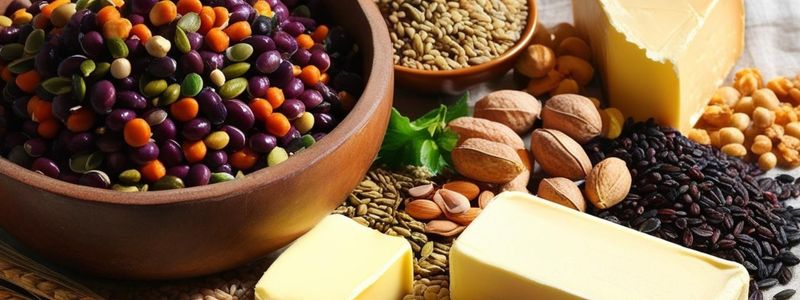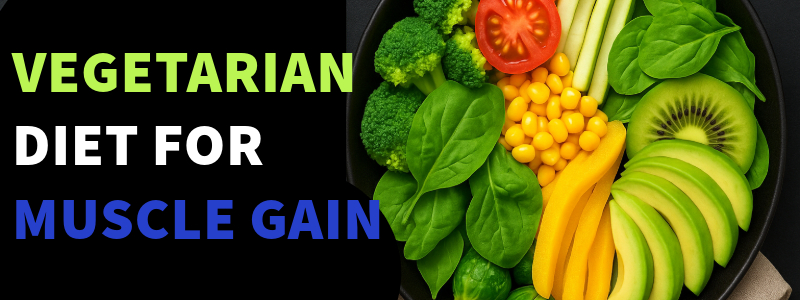While it can be challenging to gain strength on a vegetarian diet, you aren’t going to have small muscles because you avoid from meat. Even though high-protein animal products are frequently associated with muscle gain, there are many of plant-based diets that can promote muscle growth just as effectively. We’re going to provide you a comprehensive vegetarian diet plan for muscle growth in this post. If you follow it correctly, it’s likely one of the healthiest and most economical ways to build muscle over the long term.
A few fundamental ideas are included in an effective vegetarian muscle-building program.
Protein Overload: Building and recovering muscles requires protein. Vegetarians should pay particular attention to ensuring they consume adequate protein from plant-based foods such seitan, tofu, tempeh, and legumes.
The excess and the deficit: Simple Steps To Gain Strength And Reduce Fat A calorie surplus—that is, consuming more calories than you expend—is necessary for muscle growth. This will guarantee you have adequate energy and help you consume enough protein throughout the day.
Balanced Macronutrients: The key to a healthy diet is eating meals that are well-balanced. Healthy fats support hormone production and overall health, while carbohydrates provide the energy you need for exercise.
Based on these ideas, vegetarians can create a muscle-building diet that works for them and meets their objectives.
Methods for Calculating Your Calorie Count
Always figure out how many calories you need each day before starting a diet, and then modify your intake according to your muscle-gain objectives. Here is a step-by-step guide on doing it:
Calculate the Calories You Need for Maintenance: The number of calories your body needs in a given day to maintain its current weight is known as maintenance calories. To locate this:
Here is a very simple method for using the Harris-Benedict Equation to estimate your BMR.
BMR for men is equal to 66.5 + (13.75 × weight in kg) + (5.003 × height in cm) − (6.75 × age in years).
For females, BMR is equal to 655 + (9.563 × weight in kilograms) + (1.850 × height in centimeters) − (4.676 × age in years).
Use the following multipliers to multiply your BMR by your amount of activity: BMR × 1.2 for little to no exercise
BMR × 1.375 for a light exerciser (one to three days per week)
Lightly active: BMR × 1.375 (mild exercise 1-3 days per week) Moderately active: BMR × 1.55 (moderate activity three to five days per week)
BMR × 1.725 for extremely active people who engage in severe exercise 6-7 days a week
A contributing factor to bulking (muscle growth): Once your baseline metabolic rate has been established, you will also need to build muscle by creating a surplus around this figure. Generally speaking, adding 300–500 calories per day is the maximum amount that is allowed for a bulk.
Make adjustments for fat loss (cutting): You will want to be in a slight calorie deficit if you wish to lose fat while gaining muscle. A cut usually results in a calorie reduction of 10–20%.
Modify Calorie Needs: Your body may require more calories as you gain muscle, so every three to four weeks, reevaluate your calorie requirements and raise your consumption.
Creating a 7-Day Diet Plan to Build Muscle
This is an example vegetarian diet plan that has been tailored to help people grow muscle. According to the Indian market, the meals are nutrient-dense and offer a balance of macronutrients in each meal.
Day 1:
High-Protein Breakfast Banana, chia seeds, almonds, and oatmeal for breakfast.
Snack in the Middle of the Morning
Nut-Based Energy Boost
They served a big glass of delicate coconut water with some mixed nuts (almonds and cashews).
Lunch: An Indian Meal High in Protein
Yogurt, vegetables, lentil curry (dal), and whole-wheat flatbread.
High-Calorie Snack in the Evening: Smoothie
Smoothie with peanut butter and bananas and a scoop of plant-based protein powder.
Dinner is a salad high in protein.
Quinoa salad with lemon dressing, chickpeas, cucumber, tomato, and olive oil.
Day 2:
Tofu Scramble with Vegetables for Breakfast
Whole grain toast with scrambled tofu, spinach, tomatoes, and peppers and onions
Fruit and Nut Combination for a Mid-Morning Snack
Almond butter atop an apple slice.
Lunch consists of brown rice, paneer tikka masala, and a mixed vegetable curry.
Greek Yogurt with Berries for an Evening Snack
Chobani with flax and berries.
Dinner is an avocado and chickpea bowl.
Quinoa, sliced avocado, and chickpea curry.
Day 3:
A smoothie bowl consisting of granola, banana, almond milk, and spinach.
Energy Bar for Snacks in the Midmorning
homemade energy bar with oats, date seeds, and nuts.
Roti & Mixed Dals for Lunch
Green and yellow dal were combined with whole wheat flatbread.
Veggies and Hummus for an Evening Snack
Raw vegetables (cucumber, carrots, bell pepper spears, etc.) with hummus
Vegetables and Millet for Dinner Stir-Fry
Stir-fried vegetables with millet and tofu.
Day 4:
Fruit and Muesli for Breakfast
Muesli with soy milk, almonds, and dried fruits.
Snack in the middle of the morning: sliced avocado with lime
Whole grain bread, a little lime for energy, and a pinch of Chile powder are used to make avocado toast.
Lentil and Spinach Soup for Lunch
Accompany the dish with whole-grain bread. Lentil and Spinach Soup
Snack in the evening
Pineapple with Cottage Cheese
Paneer and fresh pineapple cubes.
Dinner: Stir-fried vegetables and tofu
Brown rice, broccoli, bell peppers, and carrots are added to stir-fried tofu.
Day 5:
Morning meal
Overnight Oats
Almond milk, chia seeds, and mixed berries with overnight oats.
Protein Bar, a plant-based “fuely” bar produced from nuts and seeds, is a midmorning snack.
Lunch is a vegetarian biryani served with raita and tofu.
Protein Snack in the Evening Mix one plant-based drink with a tablespoon of peanut butter and almond milk.
Sweet potatoes stuffed for supper
Avocado, grain, and black beans are filled into sweet potatoes.
A Vegetarian Diet Chart’s Dos and Don’ts for Building Muscle
Dos:
Eat frequently: In order to maintain a calorie surplus and continue providing your body with nutrients, aim to eat five to six meals every day.
Choose foods high in calories: To increase your calorie intake, include healthy fats like avocados, almonds, and olive oil.
SET PROTEIN FIRST Make it a point to include protein in each meal, especially plant-based proteins like quinoa, beans, lentils, tofu, and tempeh.
Hydrate: To sustain healthy muscles and general well-being, drink water.
Extras: Proceed with caution: Both creatine and plant-based protein supplements may aid in muscle growth.
Don’ts:
Avoid junk: To maintain the health of your muscles and fat, refrain from nibbling on refined, salty, and deep-fried foods.
Avoid missing meals: By lowering your calorie intake and muscle regeneration, skipping meals can hinder your progress. Forget sleep: For the optimum muscle growth and repair, try to get 7 to 8 hours of sleep.
Foods Supported by Studies

Legume: Legumes, such beans, lentils, and chickpeas, are excellent plant-based choices since they are high in fiber and protein.
Seeds and Nuts: Seeds and Nuts Rich in protein and excellent fats, almonds, walnuts, chia seeds, and flax seeds are all beneficial for muscle growth.
Whole-Fat Dairy: Dairy products like milk, cheese, paneer, and yogurt give you a healthy dose of calcium and protein if you’re not vegan.
Whole Grains: Oats, quinoa, and brown rice are complex carbs that help with muscle rehabilitation and provide energy throughout exercise.
Strength Training’s Function
Put a priority on physical activity, especially strength training, as this promotes muscular growth. A vegan diet may supply the necessary nutrients, but regular resistance training—such as bodybuilding is necessary to activate muscle fibers and avoid hypertrophy. Additionally, you should concentrate on progressive overload, which involves gradually increasing the weight or intensity over time.
The Challenges of a Vegetarian Diet Plan for Building Muscle
Low protein intake: It’s important for vegetarians to pay closer attention to getting enough protein from non-meat sources.
Calorie control: Risking an excess of calories on a vegetarian diet without consuming too many processed foods can be more challenging.
Insufficient dietary diversity: Some vegetarians struggle to consume a sufficient range of foods for a balanced diet.
In conclusion
Being a vegetarian and building muscle requires commitment, preparation, and consistency. You can achieve animalistic increases as a plant-based eater with a healthy diet and respectable exercise.
Share this article on
FAQ’S
Can I build muscle effectively on a vegetarian diet?
Absolutely. With a well-planned vegetarian diet rich in protein, complex carbohydrates, and healthy fats, you can achieve significant muscle growth. Key protein sources include legumes, tofu, tempeh, seitan, dairy products, eggs, nuts, seeds, and whole grains. Combining these with resistance training supports muscle development.
How much protein do I need daily for muscle gain?
For muscle building, aim for 1.2 to 2.0 grams of protein per kilogram of body weight (approximately 0.5 to 0.9 grams per pound). For instance, a 70 kg (154 lbs) individual should consume between 84 to 140 grams of protein daily.
Do I need supplements like protein powder?
Supplements are optional but convenient for meeting protein goals. Plant-based protein powders (e.g., pea, brown rice) or fortified B12/iron supplements can help fill nutritional gaps.
